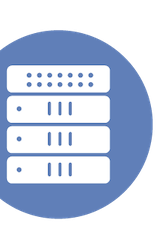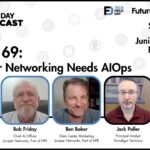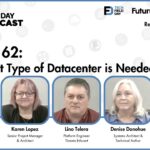AI will need less HBM (high bandwidth memory) because flash memory unification is changing training and inference. This episode of the Tech Field Day podcast features Sebastien Jean from Phison, Max Mortillaro, Brian Martin, and Alastair Cooke. Training, fine-tuning, and inference with Large Language Models traditionally use GPUs with high bandwidth memory to hold entire data models and data sets. Phison’s aiDaptiv+ framework offers the ability to trade lower cost of infrastructure against training speed or allow larger data sets (context) for inference. This approach enables users to balance cost, compute, and memory needs, making larger models accessible without requiring top-of-the-line GPUs, and giving smaller companies more access to generative AI.
The AI Memory Crisis (And How One Company Thinks They’ve Solved It)
As enterprises increasingly deploy AI applications, they face a significant bottleneck due to the limitations of conventional memory architectures. In response, Phison claims to have developed a solution that addresses this critical “AI Memory Crisis” by enhancing memory efficiency and scalability. Discover additional insights about AI Infrastructure Field Day 2 in our coverage on LinkedIn Pulse featuring Jack Poller.
Datacenter Networking Needs AIOps with HPE Juniper Networks
Enterprise networking is too large and complex, we need AI Operations. This spotlight episode of the Tech Field Day podcast features Bob Friday and Ben Baker, both from Juniper Networks, with Jack Poller and Alastair Cooke. Modern enterprise networks reach far beyond the well-controlled walls of data centres and corporate buildings. The rate of change enabled by public cloud platforms makes an enterprise network highly dynamic. Access to cloud and on-premises applications over the Internet means your users are dependent on many network elements outside of your control. Bob founded Mist Networks to help businesses manage the complexity of user-to-cloud networking. Juniper Networks acquired Mist, and now HPE has acquired Juniper. I don’t think he is alone in seeing the necessity of using AI to manage complex and critical networks. Yet new tools always bring new challenges; the cost of AI infrastructure may be a concern, and Generative AI has challenges with hallucinations. The security and governance practices around AI tools are still developing, and the non-deterministic nature of AI needs careful consideration.
The AI Infrastructure Bottleneck No One Talks About
Jack Poller sheds light on the seldom-discussed AI infrastructure bottleneck, highlighting the limitations in current technologies that could potentially hinder AI applications’ effectiveness. He explores the complexity of balancing computational power, data storage capacity, and network capabilities to optimally support AI workloads. For more insights on Netris, you can check out additional coverage from Security Field Day 13 on LinkedIn Pulse.
Breaking the AI Storage Bottleneck: Solidigm’s Strategic Approach to Each Pipeline Stage
Jack Poller provides an insightful analysis into how Solidigm is addressing the AI storage bottleneck by strategically catering to each stage of the data pipeline. He explores the technological advancements and solutions implemented by Solidigm that enhance both the efficiency and effectiveness of AI data processing. For more in-depth analysis on AI Infrastructure Field Day 2 by Jack Poller, visit Techstrong AI.
Feeding the Beast: How Keysight Ensures AI Networks Can Handle Data-Hungry GPUs
Jack Poller discusses how Keysight Technologies effectively addresses the challenges of maintaining robust networks that feed data to power-hungry GPUs, which are crucial for AI development. He explores Keysight’s innovative solutions that optimize network performance and reliability to meet the demands of intensive AI workloads. Discover more insights on AI Infrastructure Field Day 2 from Jack Poller at Techstrong AI.
Orchestrating the Future of AI Networking with Software-Defined Solutions from Aviz
Jack Poller recently highlighted the advancements in AI networking facilitated by Aviz’s software-defined solutions, pointing out their potential to revolutionize AI infrastructure management. He detailed how these solutions offer enhanced scalability, efficiency, and automation, setting a new benchmark in network orchestration. Explore additional insights from AI Infrastructure Field Day 2 in articles on Techstrong AI by Jack Poller.
SSD Innovation for AI from Solidigm
Alastair Cooke recently explored the advancements in SSD technology tailored for AI applications, specifically from Solidigm. Highlighting the impact of next-generation SSDs, Cooke discusses how these innovations enhance data processing speeds crucial for AI workloads. For more on AI Infrastructure Field Day 2, you can find comprehensive coverage by Alastair Cooke.
Osmium Update – 9-May-25 – Some Tech Field Day AIIFD2 Highlights!
On the May 9 Osmium Update, Max Mortillaro and Arjan Timmerman discussed AI Infrastructure Field Day 2, where Nutanix presented a new AI solution that deploys AI infrastructure on various platforms and provides model management and validation services. Phison showcased their AI adaptive solution for optimizing AI workloads and leveraging existing infrastructure for cost-effective AI solutions.
A Different Type of Datacenter is Needed for AI
AI demands specialized data center designs due to its unique hardware utilization and networking needs, which require a new type of infrastructure. This Tech Field Day Podcast episode features Denise Donohue, Karen Lopez, Lino Telera, and Alastair Cooke. Network design has been a consistent part of the AI infrastructure discussions at Tech Field Day events. The need for a dedicated network to interconnect GPUs differentiates AI training and fine-tuning networks from general-purpose computing. The vast power demand for high-density GPU servers highlights a further need for different data centers with liquid cooling and massive power distribution. Model training is only one part of the AI pipeline; business value is delivered by AI inference with a different set of needs and a closer eye on financial management. Inference will likely require servers with GPUs and high-speed local storage, but not the same networking density as training and fine-tuning. Inference will also need servers adjacent to existing general-purpose infrastructure running existing business applications. Some businesses may be able to fit their AI applications into their existing data centers, but many will need to build or rent new infrastructure.
Solidigm: Building AI Storage Foundations
Max Mortillaro provides an insightful analysis on Solidigm’s approach to structuring AI-enabled storage solutions, emphasizing their strategic efforts to underpin the increasingly demanding needs of AI infrastructures. He examines the company’s innovative methodologies and technologies that aim to enhance performance and scalability in data-intensive environments. For comprehensive insights into AI Infrastructure Field Day 2, watch the Osmium Data Group website!
Make an AI-Ready Data Center With Help From Juniper
Alastair Cooke explores the crucial role of Juniper Networks in preparing data centers for AI workloads, emphasizing optimized network architecture that supports the demanding requirements of AI technologies. He discusses Juniper’s solutions that streamline operations and enhance the efficiency necessary for handling intensive AI-driven processes. For additional insights on AI Infrastructure Field Day 2, see Alastair Cooke’s coverage on The Futurum Group.
Google Cloud Provides a Complete AI Portfolio
Andy Banta highlights the comprehensive AI portfolio provided by Google Cloud, which is designed to cater to various business needs ranging from foundational models to tailored solutions for enterprise challenges. This coverage showcases the depth and flexibility of Google Cloud’s offerings in the AI space, affirming its position as a significant player in the industry. For additional insights into AI Infrastructure Field Day 2, explore more articles on Techstrong AI.
AI Infrastructure Gets ‘Googleier’
Google Cloud’s AI Hypercomputer platform simplifies the AI lifecycle with integrated hardware, software, and networking. It offers scalable solutions for large-scale AI workloads, powered by GKE and custom silicon like Trillium TPU. Read more in this Techstrong AI article by Jay Cuthrell.
Scaling AI: Mastering Inference with Google Cloud’s GKE Inference Gateway
Jack Poller provides an insightful analysis of how Google Cloud’s GKE Inference Gateway is pivotal in optimizing the scaling of AI through efficient model inference. His coverage highlights the integration capabilities of GKE, demonstrating its effectiveness in managing diverse AI application demands. For more in-depth insights, explore additional coverage of AI Infrastructure Field Day 2 by Jack Poller.
Build Your Own AI Infrastructure Using Google Cloud
Alastair Cooke explores the practicalities and advantages of constructing your own AI infrastructure using Google Cloud, highlighting the accessibility and customization benefits that come with building a bespoke environment. He provides insights into how organizations can leverage Google Cloud’s robust tools and services to tailor AI solutions to their specific needs, enhancing both efficiency and scalability. For additional insights and extensive coverage of AI Infrastructure Field Day 2, watch The Futurum Group blogs.










